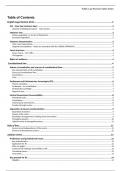Summary
PUBLIC LAW SQE1 SUMMARY
Hi fellow law student! I'm selling my SQE1 English Legal System notes that helped me score in the top 20% of the exam. These notes are well-organised, easy to follow, and packed with all the key information you need to succeed. What’s Inside: English Legal System (ELS) Overview Case Law (C...
[Show more]



